My Blake
Dmitri Nikolaevich Smirnov (dmitrismirnov@hotmail.co.uk) is a Russian and British composer, born in Minsk into a family of opera singers and now living in St. Albans, Hertfordshire. He studied at the Moscow Conservatory 1967–72 and in 1979 was blacklisted as one of “Khrennikov’s Seven” at the Sixth Congress of the Union of Soviet Composers for unapproved participation in some festivals of Soviet music in the West. He was one of the founders of Russia’s new ACM (Association for Contemporary Music), established in Moscow in 1990. Smirnov has resided in England since 1991 and has taught at Goldsmiths, University of London, since 2003. Many of his works reflect his fascination with the poetry and art of William Blake. He has translated into Russian all the literary works of Blake except the poem Vala, or The Four Zoas, which he is now working on.
Part 1: In Russia
I grew up in a country where English literature was considered exemplary, and it was faithfully translated into my native language by many generations of eminent translators. British or American classics were almost as popular as Russian, but of course William Shakespeare always stood in the first place and eclipsed all other authors of the world. Therefore, it is not surprising that in my early youth, when I began to write music and was looking for texts for my vocal compositions, I initially turned to setting some of Shakespeare’s sonnets from the most popular Russian translation, by Samuil Marshak. I had only started studying English then.
One day in 1967, when by chance in a bookshop, I bought a Soviet book with an English title, In the Realm of Beauty, a collection of English-language poetry printed in English. I was struck by William Blake’s short quatrain
To see a World in a Grain of Sand
And a Heaven in a Wild Flower
Hold Infinity in the palm of your hand
And Eternity in an hour.
It impressed me with its depth and universality–an incredible flight of the imagination while, at the same time, an amazing simplicity. I immediately felt that I had found the main thing I was looking for in art, poetry, music, and in life itself. After translating it into Russian I began to translate everything from that book–there were works of Shakespeare, Byron, Shelley, Coleridge, Keats, Burns, Edgar Allan Poe, and many other great poets, but Blake drew me in more than anybody else. Back then, I could not have foreseen how much this hobby would affect my music and life, causing me eventually even to emigrate to the country of the English bards. Later my wife, Elena Firsova, also a composer, set my first translation to music for chorus and orchestra in Augury, op. 38, 1988, one of her most monumental works, commissioned by and performed at the BBC Proms in London.

However, the list of my works setting Blake to music begins with another piece, The Crystal Cabinet for violin and piano (or celesta), op. 27g, 1979.
I was enchanted by Blake’s poem of the same title from the Pickering Manuscript that begins The Maiden caught me in the WildWhere I was dancing merrily
She put me into her Cabinet
And Lockd me up with a golden Key. The poem tells the story of a miraculous meeting of a young man with a translucent threefold maiden “each in the other closd” with her threefold smile and threefold kiss. It gave me the simple but rather unusual structural idea to compose a piece in which every bar of the accompaniment contains four triads made of different notes but together embracing a complete chromatic scale. The series of these triads forms multiple and always different combinations, and on top of this harmony appears the melodious line of the violin, which is built of the notes suggested by the triads of the accompaniment.

In December 1979 one of the most pivotal of my compositions was completed—The Seasons for voice, flute, viola, and harp, op. 28, the setting of four Blake verses from his earliest collection, Poetical Sketches: “To Spring,” “To Summer,” “To Autumn,” and “To Winter.” The cycle begins
O thou, with dewy locks, who lookest down
Thro’ the clear windows of the morning; turn
Thine angel eyes upon our western isle,
Which in full choir hails thy approach, O Spring!
It was difficult to believe that these beautiful and powerful poems were written by such a young man—the four seasons were treated by Blake as a complete cycle of a human life from birth to death. It was a real pleasure to set to music such wonderful poetry; this was my first serious musical turn to Blake, which later grew into a kind of conversion to Blake’s faith. I’ve found that the soprano voice, together with such an exquisite instrumental combination, is indeed capable of communicating some powerful drama. I extracted the pitch material from different segments of the natural overtone scale, guided by the intuitive idea of the emotional color of certain musical intervals that could transmit the images of the seasons of the year. The intervallic materialPitch material and intervallic material are interconnected; there is, however, a principal distinction between them. Pitches are particular notes: A, B-flat, C, D-sharp, etc. Intervals are the distances between notes: minor and major seconds, thirds, perfect fourths, fifths, etc., taken melodically (one after another) or harmonically (simultaneously) from any pitch. of a young, ecstatic Spring is the cohesion of two minor thirds through a major second, in semitones, +3-2+3, where plus means an ascending interval and minus a descending one; a more calm and balanced Summer is identified with two major thirds connected by a minor third, +4-3+4; Autumn, sad and burdened with fruits, is expressed by the conjugation of two minor seconds through a perfect fifth, +1+7-1; and a cold, gloomy Winter is depicted with the “deadest” of intervals, the tritone linked to another tritone by means of a minor second, +6+1+6.
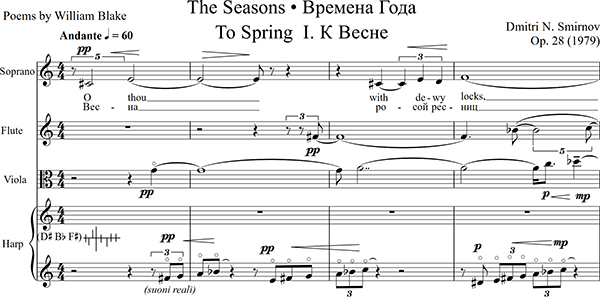
In May 1980 I decided to write a symphony in four movements based on my song cycle The Seasons to recreate the music by only symphonic means, without singing, just as a painter turns his black-and-white sketch into a colorful canvas. I was encouraged by the example of Gustav Mahler with regard to his symphonies, some of which were written on the basis of his vocal cycles. My First Symphony (The Seasons) for large symphony orchestra, op. 30, was completed in September 1980 and dedicated to the memory of Blake.
The premiere took place on 8 October 1981 in Riga; Vassily Sinaisky conducted with great inspiration and the Latvian State Symphony Orchestra played excellently. After that, quite a few performances followed: in Moscow, Gorky (now Nizhny Novgorod), Dzerzhinsk, Tanglewood (Massachusetts, USA), Daegu (South Korea), London, The Hague, and twice in Columbus (Ohio, USA). I attended most of these events, which was great fun. The score was printed by Sovetsky Kompozitor Publishers, Moscow, 1988; now the publishing rights belong to Boosey & Hawkes, London.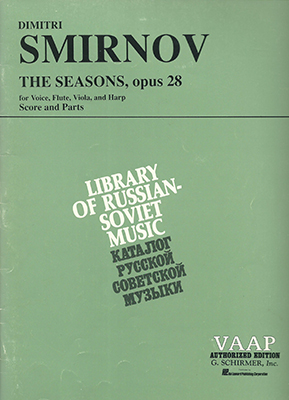

Right: First Symphony (The Seasons) (Moscow: Sovetsky Kompozitor, 1988).
In January 1981 I wrote the song cycle Fearful Symmetry, Six Poems by William Blake for voice and organ, op. 32, that includes “To Apollo”—an excerpt from “An Imitation of Spenser”—and “To the Muses” (both from Poetical Sketches), “Morning” and “Day” (from the Notebook), and “The Sick Rose” and “The Tyger” (from Songs of Experience). It premiered five years later, 10 March 1986, in Moscow with Lydia Davydova, soprano, and Ekaterina Prochakova, organist. Much later I created a version for voice and piano, op. 32a, 1981/2003/2010. The first, fourth, and fifth songs are available here:
The music of “To the Muses” also became the basis of my Ballade, op. 35, 1982, for alto saxophone and piano. The music of “The Tyger” I rearranged a few times for different casts of performers (opp. 41, 61, 61a, and 132). All the texture of my setting of “The Tyger” is based on the idea of “fearful symmetry”: everything that appears in the lower register of the accompaniment is mirrored later in the upper one, and vice versa:
In addition to composing music, I used my spare time to translate English poetry into Russian, and when I finished working on Blake’s early lyrics, I approached his first so-called prophetic poems. On 18 February 1983 I finished a translation of Tiriel, which I worked on with great enthusiasm because I felt that this was the thing that I had been seeking for so long, an excellent operatic plot: a former tyrant, removed from power and filled with the thirst for revenge, sends devastating, malicious curses to all destined to cross his path—his sons, daughters, brothers, dear old parents, and, finally, to himself, and by this he brings death to all humanity. I read the translation to my wife, Elena, and she approved my idea for the opera. For a few days I worked on a libretto, and then on 24 February began to compose the music.For more information on the opera, see <https://en.wikipedia.org/wiki/Tiriel_(opera)>; for the libretto, see <http://wikilivres.ru/Tiriel_(libretto)>.
I began the symphonic prologue to Tiriel after inventing a specific system of repetitions of the sounds of a twelve-tone series that is reminiscent of a rope twined with two identical strings. The eminent Russian musicologist Yuri Kholopov comments: The composer began his composition with a Prologue (a kind of overture), based on a series that is symmetrical in its structure …. The individual mode comes from the principle of imitative interpolation of a pair of identical series leading to a regular repetition of the sound pitches … and even to the obvious tonal colouring (quasi g-moll).Yuri Kholopov, “Nashi v Anglii. Dmitri Smirnov, Elena Firsova,” Muzyka iz byvshego SSSR, vypusk 2 (Moscow: Kompozitor, 1996) 265; in English as Yuri Kholopov, “Russians in England: Dmitry Smirnov, Elena Firsova,” “Ex oriente …—I”: Ten Composers from the Former USSR (Berlin: Verlag Ernst Kuhn, 2002) 207-66.
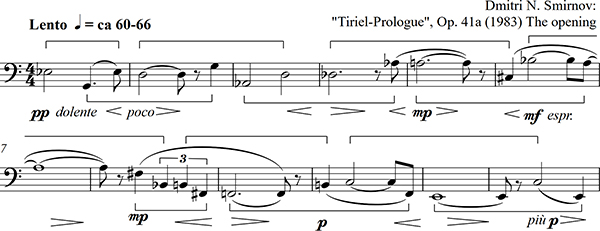
Tiriel, op. 41, for soloists, chorus, dancers, and full symphony orchestra, was completed in January 1985.
In thy little heart asleep.
When thy little heart doth wake,
Then the dreadful lightnings break.
From thy cheek & from thy eye
O’er the youthful harvests nigh
Infant wiles & infant smiles
Heaven & Earth of peace beguiles. I reused the music of this lullaby in the second movement of my Second String Quartet, op. 42, 1985, which I dedicated to my son, Philip, who had just been born on 8 April.
After this I began writing my second opera, The Lamentations of Thel (or just Thel), op. 45, after The Book of Thel. I liked that intimate and lyrical parable about a girl, Thel, who complains of her future death and searches for the meaning of life. When I read to Elena my just completed translation of the poem, she said, “This is about me.” I explained that was why I decided to write an opera setting this story. I worked on this chamber opera between 1985 and 1986. It became a sort of sequel to Tiriel, but much shorter, with a smaller cast: it required only four singers, a small chorus, and an ensemble of sixteen players.For more information, see <https://en.wikipedia.org/wiki/Thel_(opera)>.
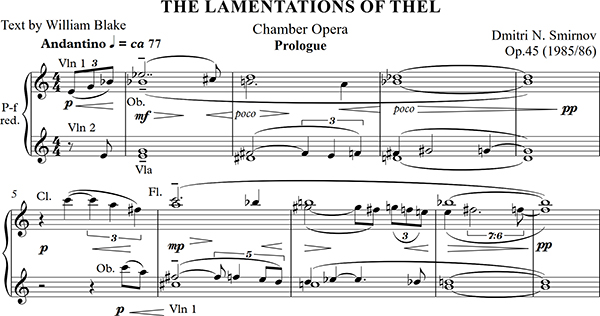
In Moscow we didn’t live in complete isolation from the world. Foreign guests—composers, musicians, publishers—who increasingly visited us, were interested in our new scores, which they took with them to their homes. Jürgen Köchel from Hans Sikorski Publishers took the score of Tiriel to Hamburg, and David Drew from Boosey & Hawkes took Thel to London, assuring me that it was for them. Soon I received a telegram from Köchel reporting the place and date of the premiere of Tiriel: Freiburg, Germany, on 28 January 1989. It was going to be staged in the German translation by Paul Esterházy, directed by Siegfried Schoenbohm and conducted by Gerhard Markson. Eight performances of the opera were announced. This was followed by a phone call from Gerard McBurney from London, who delighted me with the news that Thel would be staged by the company Théâtre de Complicité at the Almeida Theatre, London, on 9, 10, and 11 June 1989, under the baton of the young and enthusiastic conductor Jeremy Arden. Soon we learned more news: in August 1989 Elena and I were invited to Tanglewood, where Oliver Knussen would conduct my First Symphony (The Seasons). All this turned out to be an amazing gift for my fortieth birthday.

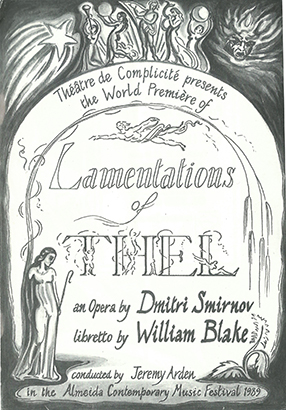
Right: The poster for Thel, London, UK, 1989.
In 1987–88 at the request of Liza Wilson, cellist and director of the Chameleon Ensemble, I wrote a chamber cantata called Songs of Love and Madness, op. 49, for voice, clarinet, celesta, harp, and string trio. For the text I chose four early Blake songs: “How Sweet I Roam’d,” “My Silks and Fine Array,” “Love and Harmony Combine,” and “Mad Song.” It premiered in November 1990 at the Huddersfield Festival with Margaret Field, soprano, the Chameleon Ensemble, and Andrew Ball, who conducted and played celesta at the same time.
The next work, written in April to June of 1988, was a piano cycle, The Seven Angels of William Blake, op. 50.

In 1988 I received a commission from the Nash Ensemble for a new chamber work, and I immediately thought about Blake’s astonishing watercolor Malevolence. I wanted to reflect its striking images in music. Blake himself explained the subject: “A Father taking leave of his Wife & Child. Is watchd by Two Fiends incarnate. with intention that when his back is turned they will murder the mother & her infant.” I chose instruments that correspond to the characters of the picture: the viola, piccolo, and violin represent the positive characters of the father, child, and mother, whereas the bass clarinet and double bass represent the two villains of the piece; the full moon at the center of Blake’s composition that shines out good and evil in equal measure is represented by the cello. I thought about the piece as a kind of visionary ballet and included in it a theatrical effect: the viola player, who represents the father, leaves the stage in the middle of the performance and then plays from the balcony. I called the piece The Moonlight Story, op. 51.
The score was finished 14 August 1988 in Moscow and the work premiered 8 June 1989 at the Almeida Theatre, London, with the Nash Ensemble and Lionel Friend, conductor. The piece became the first part of my visionary ballet Blake Pictures. Later I traveled to Philadelphia especially to see this picture in the Museum of Art. It was hidden in special storage, but I was allowed to see and keep the picture in my hands for an hour. It was an exceptional experience, and to my surprise I discovered that the colors of the picture radiate light.When I worked on my First Violin Concerto, op. 54, 1990, for violin and string orchestra, I thought about Blake’s beautiful picture Jacob’s Dream and tried to reflect its ascending and descending images. Soon after completing a short diptych for chorus a capella, From Evening to Morning, op. 55, 1990, a set of two Blake poems (“To the Evening Star” and “To Morning” from Poetical Sketches), I received a commission from the Michael Vyner Trust to compose a new piece for a large instrumental ensemble. This gave me an opportunity to continue my visionary ballet Blake Pictures, with Jacob’s Ladder for sixteen players, op. 58, 1990, a piece dedicated to the memory of Michael Vyner. Here I returned to Blake’s watercolor Jacob’s Dream, c. 1805, which depicts a giant spiral staircase descending from a sun to Jacob, stretched out asleep on a rock, with winged creatures gliding up and down. I represented the ladder using different scales (including the overtone series) and their mirror forms. The figure of Jacob is represented by a solo bassoon; the stars in the blue sky with bell-like metal percussion, harp, and celesta; the angels by string and wind instruments; and the words spoken by God by the bass drum. The work premiered on 17 April 1991 at Queen Elizabeth Hall, London, with the London Sinfonietta conducted by Gennady Rozhdestvensky. The score was printed by Boosey & Hawkes.
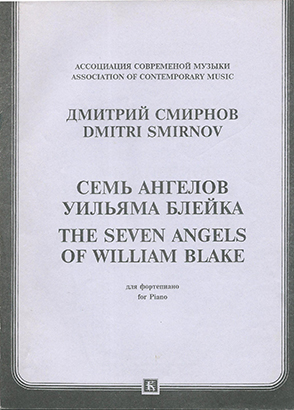
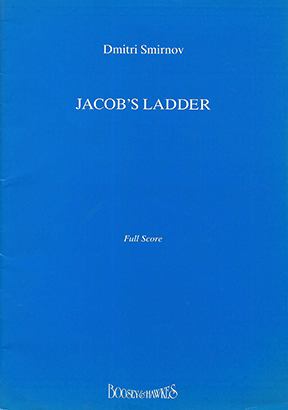
Right: Jacob’s Ladder (London: Boosey & Hawkes, 1993).
My last work written in Soviet Russia was A Song of Liberty, op. 59, 1991, an oratorio setting the epilogue of the same title from Blake’s prophetic phantasmagoria The Marriage of Heaven and Hell. It was commissioned by the Leeds Festival Chorus for their 135th anniversary, to be performed together with Mozart’s C minor Mass on 30 January 1993 at the Leeds Town Hall, with the Leeds Festival Chorus and the BBC Philharmonic Orchestra conducted by Jerzy Maksymiuk. I used the same cast as in Mozart’s mass: four singers and mixed chorus and orchestra, adding only some percussion instruments and harp. This work comprises nine movements:
1. “The Eternal Female Groan’d,” Introduction
2. “Albion’s Coast, the American Meadows,” Passacaglia
3. “Shadows of Prophecy,” Soprano aria
4. “France, Spain, Rome,” Canon
5. “The New Born Terror,” Fantasia I
6. “The Fire,” Chorale
7. “Londoner, Jew, African,” Quartet
8. “The Fiery Limbs,” The Battle of Liberty, Fantasia II
9. “Priests of the Raven,” Final chorus

Step by step times were changing. In the so-called perestroika period my wife and I were able to go abroad more and more to attend performances of our music. I had visited a few Western European countries, Poland, the United States, and even South Korea. I had been to England three times already, attending performances of The Seasons in 1988, The Lamentations of Thel and The Moonlight Story in 1989, and Songs of Love and Madness in 1990. I had viewed the remarkable display of Blake’s paintings and drawings at the Tate, and in the British Library I was given the opportunity to see a selection of his manuscripts and to read from the original copies of books printed and colored by his own hand. It made me think of this country as the place I especially would like to live. At the same time, the political situation in Russia began to look uncertain: Mikhail Gorbachev was definitely losing his power, and our colleagues and friends, composers and musicians, were looking for any possibilities to abandon the sinking ship.
In January 1991 in Moscow I suddenly received a postcard from Kathleen Raine, whom I had never met before but whose wonderful books about Blake I loved very much. She wrote that she had been very surprised to learn from some of her friends that in Russia there is a composer who is crazy about Blake, as she is. And she asked me when I was next in London to come to her place at 47 Paulton Square for a cup of tea. I answered that I was happy to accept her invitation and invited her to the performance of my Jacob’s Ladder in April at the Southbank Festival. Very soon I received her letter where she wrote: It was with great surprise and pleasure that I received your letter about Blake and your love for him and your music based on his great inner worlds. I will make every effort to come to the performance of ‘Jacob’s Ladder’ on April 17th. Of all Blake’s paintings it is probably the one I love best …. It is wonderful to think that you have made Blake renouned in Russia at this time.

The Southbank Festival sent the invitation to us in September 1990, a long time in advance, and we began to prepare documents for obtaining the visas. To our great surprise we received something that we had never received before, permission to take our small children with us: Philip was six and Alissa only four then. This suddenly opened an incredible opportunity for us to try to begin a new life in a completely different part of the world, and on 13 April 1991 we arrived in Great Britain, where we have lived ever since.
Blake Set to Music by Dmitri N. Smirnov
Works Written in Russia
1. The Crystal Cabinet, for violin and piano (or celesta), op. 27g, 1979/2010, 4 mins. Inspired by Blake’s poem of the same title.
First performance: 23 May 2014, Council Chamber, Deptford Town Hall, London. Natasha Sachsenmeier, violin, Alissa Firsova, piano.
Published: Meladina Press, St. Albans.
Recording: <https://www.youtube.com/watch?v=iCvJHLs1NZY>.
This music was reused in the following compositions:
Hermitage: Roman Portrait, TV score for orchestra, op. 27d, 1979 <https://www.youtube.com/watch?v=x1gZ7DTX0wM&t=817s> (at 13′48″)
Piano Quintet, op. 72 (second movement), 1992
The Magic Box, for piano, op. 77 (nos. 45 and 50), 1993
Well-Tempered Piano, op. 125 (nos. 7 and 13), 2000
2. The Seasons, for voice, flute, viola, and harp, op. 28, 1979, 22 mins. Four poems by Blake from Poetical Sketches: 1. “To Spring,” 2. “To Summer,” 3. “To Autumn,” 4. “To Winter.” The texts include parallel Russian translations by the composer.
First performance: 10 March 1980, Union of Composers, Moscow. Lydia Davydova, soprano, Irina Lozben, flute, Mikhail Bezruky, viola, Olga Ortenberg, harp, Sergei Skripka, conductor.
Published: G. Schirmer, New York, 1991 <https://www.amazon.co.uk/Seasons-Op-28-Voice-Flute-Viola/dp/079350449X>.
Recording: <https://www.youtube.com/watch?v=7AcctgOkIYA&t=498s>.
3. First Symphony (The Seasons), for full symphony orchestra (without singing), op. 30, 1980, 26 mins. Based on the vocal cycle The Seasons, op. 28. Four movements: 1. “To Spring,” 2. “To Summer,” 3. “To Autumn,” 4. “To Winter.”
First performance: 8 October 1981, Philharmonic Hall, Riga. Latvian State Symphony Orchestra, Vassily Sinaisky, conductor.
Published: Sovetsky Kompozitor, Moscow, 1988; Boosey & Hawkes, London.
Recording: <https://www.youtube.com/watch?v=niVW8fPT9Mo&t=632s>.
4. Fearful Symmetry, Six Poems by William Blake, for voice and organ, op. 32, 1981/2003, 18 mins. 1. “To Apollo” (an excerpt from “An Imitation of Spenser”), 2. “To the Muses” (Poetical Sketches), 3. “Morning,” 4. “Day” (Notebook), 5. “The Sick Rose,” 6. “The Tyger” (Songs of Experience). The texts include parallel Russian translations by the composer.
First performance: 10 March 1986, Union of Composers, Moscow. Lydia Davydova, soprano, Ekaterina Prochakova, organ.
Published: Meladina Press, St. Albans.
Another version of the same work:
5. Fearful Symmetry, Six Poems by William Blake, for voice and piano, op. 32a, 1981/2003/2010, 18 mins.
First performance (in part): 29 November 2011, Pushkin Museum, Moscow. Joan Rogers, soprano, Andrew West, piano.
Published: Meladina Press, St. Albans.
Recording: <https://www.youtube.com/watch?v=JY63PrEwMgk>.
6. Ballade, for alto saxophone and piano, op. 35, 1982, 8 mins. Based on the setting of Blake’s poem “To the Muses,” op. 32, no. 2.
First performance: 14 April 1982, Union of Composers, Moscow. Lev Mikhailov, saxophone, Mikhail Muntian, piano.
Published: Sovetsky Kompozitor, Moscow; Meladina Press, St. Albans.
Disc (LP): Melodia C1020849 004, USSR; CD: <https://www.amazon.co.uk/gp/product/B01I1UBA86/ref=dm_ws_sp_ps_dp>.
7. Tiriel: Prologue to the Opera, for full symphony orchestra, op. 41a, 1983, 11 mins. Associated with Blake’s dramatic poem of the same name and “A Cradle Song” (from the Notebook).
First performance: 30 October 1984, Grand Hall, Moscow Conservatory, Moscow. State Symphony Orchestra of the Ministry of Culture, Gennady Rozhdestvensky, conductor.
Published: Meladina Press, St. Albans.
Recording: <https://www.youtube.com/watch?v=XQZeBA6B8gg&t=12s>.
This music was rearranged for different combinations:
8. Tiriel, for baritone saxophone and piano, op. 41b, 1983, 9 mins.
First performance: 25 April 1984, Union of Composers, Moscow. Margarita Shaposhnikova, saxophone, Sergey Solodovnik, piano.
Published: Sovetsky Kompozitor, Moscow; Meladina Press, St. Albans.
CD: Proyecto MOCKBA, Edita Icaria, ICD128 (Spain).
Recording: <https://www.youtube.com/watch?v=UcdY-o4afts>.
8a. Tiriel, for cello and piano, op. 41c, 1983, 9 mins.
First performance: 5 March 1987, Kishinev. Ivan Monighetti, cello, Yuri Lisitchenko, piano.
Published: Boosey & Hawkes, London; Meladina Press, St. Albans.
Recording: <https://www.youtube.com/watch?v=k7-wKWPDAAk&t=38s>.
8b. Tiriel, for solo piano, op. 41d, 1983, 9 mins.
Published: Meladina Press, St. Albans.
9. Dance of the Nightingale, from the opera Tiriel, for solo piccolo, op. 43g, 1984, 2 mins.
Published: Meladina Press, St. Albans.
10. “Introduction” to Songs of Innocence (“Piping down the Valleys Wild”), from the opera Tiriel, duet for low soprano and baritone with piano, op. 41i, 1984/2011, 2 mins. The text includes a parallel Russian translation by the composer.
First performance: 29 November 2011, Pushkin Museum, Moscow. Joan Rogers, soprano, Roderick Williams, baritone, Andrew West, piano.
Published: Meladina Press, St. Albans.
11. Dance, from the opera Tiriel, for cello and piano, op. 41j, 1984/2017, 3 mins. 33 secs.
Published: Meladina Press, St. Albans.
12. Tiriel, аn opera in three acts (nine scenes) with prologue, for seven singers, male chorus, dancers, and full symphony orchestra, op. 41, 1983–85, 110 mins. Libretto by Dmitri N. Smirnov after Blake, in English or Russian (trans. Smirnov) or German (trans. Paul Esterházy). To the text of Blake’s poem Tiriel were added five more of his poems: “Introduction” (Songs of Innocence), “The Tyger” (Songs of Experience), “The Divine Image” (Songs of Innocence), “A Divine Image” (Songs of Experience), “A Cradle Song” (Notebook).
First performance (in German): 28 January 1989, Stadttheater, Freiburg, Germany. Siegfried Schoenbohm, director, Gerhard Markson, conductor.
Published: Meladina Press, St. Albans.
Recording: <https://www.youtube.com/results?search_query=Dmitri+N.+Smirnov%3ATiriel>.
13. Second String Quartet, op. 42, 1985, 14 mins. The second movement is a meditation on Blake’s “A Cradle Song” (from the Notebook).
Published: Meladina Press, St. Albans.
CD: <https://www.amazon.co.uk/dp/B00069I6Q0/sr=8-1/qid=1501323304/ref>.
Recording: <https://www.youtube.com/watch?v=PiIKnXNe-wM>.
14. Thel (The Lamentations of Thel): Prologue to the Opera, for chamber ensemble of sixteen players and choir (optional), op. 45a, 1985, 10 mins.
Published: Boosey & Hawkes, London.
Recording: <https://www.youtube.com/watch?v=W0m0OSUsrts>.
15. Thel (The Lamentations of Thel), chamber opera in four scenes with prologue, for four singers, chamber chorus, and ensemble of sixteen players, op. 45, 1986, 52 mins. Libretto by Dmitri N. Smirnov after Blake’s The Book of Thel, in English or Russian (trans. Smirnov).
First performance: 9 June 1989, Almeida Theatre, London. Théâtre de Complicité, Annabel Arden, director, Jeremy Arden, conductor.
Published: Boosey & Hawkes, London.
Recording: <https://www.youtube.com/results?search_query=Dmitri+N.+Smirnov%3A+Thel>.
16. Songs of Love and Madness, in four movements, for voice and chamber ensemble of six players (clarinet, celesta, harp, violin, viola, and cello), op. 49, 1987, 20 mins. Texts by Blake from Poetical Sketches: 1. “The Golden Cage” (“How Sweet I Roam’d”), 2. “Despair” (“My Silks and Fine Array”), 3. “Love and Harmony Combine,” 4. “Mad Song.” The texts include parallel Russian translations by the composer.
First performance: November 1990, Huddersfield Festival. Margaret Field, soprano, Chameleon Ensemble, Andrew Ball, celesta/conductor.
Published: Hans Sikorski, Hamburg.
17. The Seven Angels of William Blake, in eight movements, for solo piano, op. 50, 1988, 23 mins. Inspired by Blake’s poem Vala, or The Four Zoas. 1. “Prelude (Angel),” 2. “Lucifer, the Morning Star,” 3. “Molech, the Executioner,” 4. “Elohim Creating Adam, Adam Creating Elohim,” 5. “Shaddai’s Anger,” 6. “Pachad’s Fear,” 7. “Jehovah Appealing to Eternity,” 8. “Jesus, the Lamb.”
First performance: 23 November 1989, Glasgow University. Susan Bradshaw, piano.
Published: Kompozitor, Moscow; Meladina Press, St. Albans.
Recording: <https://www.youtube.com/results?search_query=Dmitri+N.+Smirnov+7+Angels+of+Blake>.
18. The Moonlight Story (Blake Pictures I—the first part of an imaginary ballet), for chamber ensemble of six players (piccolo, bass clarinet, violin, viola, cello, and double bass), op. 51, 1988, 14 mins. After Blake’s picture Malevolence.
First performance: 8 June 1989, Almeida Theatre, London. Nash Ensemble, Lionel Friend, conductor.
Published: Meladina Press, St. Albans.
Recording: <https://www.youtube.com/watch?v=LBAqnaxDpYM>.
19. First Violin Concerto, for violin and string orchestra, op. 54, 1990, 20 mins. A meditation on Blake’s picture Jacob’s Dream.
First performance: 10 October 1993, St. Andrew’s Hall, Norwich. Andreas Seidel, violin, Leipzig Chamber Orchestra, George Moosdorf, conductor.
Published: Boosey & Hawkes, London; Meladina Press, St. Albans.
20. From Evening to Morning, in two movements, for mixed chorus, op. 55, 1990, 12 mins. A setting of two Blake poems from Poetical Sketches: 1. “To the Evening Star,” 2. “To Morning.” The texts include parallel Russian translations by the composer.
Published: Meladina Press, St. Albans.
21. Jacob’s Ladder (Blake Pictures II—the second part of an imaginary ballet), for chamber ensemble of sixteen players, op. 58, 1990, 14 mins. After Blake’s picture Jacob’s Dream.
First performance: 17 April 1991, Queen Elizabeth Hall, London. London Sinfonietta, Gennady Rozhdestvensky, conductor.
Published: Boosey & Hawkes, London; Meladina Press, St. Albans.
22. A Song of Liberty, an oratorio in nine movements, for four singers, chorus, and orchestra, op. 59, 1991, 42 mins. A setting of “A Song of Liberty” from Blake’s The Marriage of Heaven and Hell. 1. “The Eternal Female Groan’d” (Introduction), 2. “Albion’s Coast, the American Meadows” (Passacaglia), 3. “Shadows of Prophecy” (Soprano aria), 4. “France, Spain, Rome” (Canon), 5. “The New Born Terror” (Fantasia I), 6. “The Fire” (Chorale), 7. “Londoner, Jew, African” (Quartet), 8. “The Fiery Limbs” (The Battle of Liberty, Fantasia II), 9. “Priests of the Raven” (Final chorus). The texts include parallel Russian translations by the composer.
First performance: 30 January 1993, Leeds Town Hall. Leeds Festival Chorus, BBC Philharmonic Orchestra, Jerzy Maksymiuk, conductor.
Published: Boosey & Hawkes, London; Meladina Press, St. Albans.
Recording: <https://www.youtube.com/watch?v=Bt0w-FthnaI> (seventh movement).
Part 2: In England will appear in our summer 2018 issue (vol. 52, no. 1).
